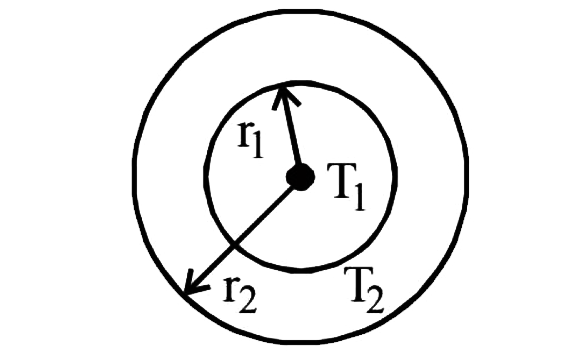Two spherical black bodies of radii R1 and R2 and with surface temperature T1 and T2 respectively radiate the same power. R1/R2 must be equal to
(T1T2)2
(T2T1)2
(T1T2)4
(T2T1)4
The correct Answer is:B
To solve the problem, we need to use the Stefan-Boltzmann law, which states that the power emitted by a black body is proportional to the fourth power of its absolute temperature and its surface area.
1. Understand the Stefan-Boltzmann Law:
The power P emitted by a black body is given by the formula:
P=σAT4
where σ is the Stefan-Boltzmann constant, A is the surface area, and T is the absolute temperature.
2. Calculate the Surface Area of Spherical Bodies:
For a sphere, the surface area A is given by:
A=4πR2
where R is the radius of the sphere.
3. Set Up the Power Equations for Both Bodies:
Let the two spherical bodies be denoted as Body 1 and Body 2. Since both bodies radiate the same power, we can write:
P1=P2
This gives us:
σ(4πR21)T41=σ(4πR22)T42
Since σ and 4π are constants, they can be canceled out:
R21T41=R22T42
4. Rearranging the Equation:
Rearranging the equation gives:
R21R22=T42T41
Taking the square root of both sides, we have:
R1R2=T22T21
5. Final Result:
Thus, the ratio of the radii R1R2 must be equal to:
R1R2=T22T21
Conclusion:
The ratio R1R2 is equal to T22T21.
The power P emitted by a black body is given by the formula:
P=σAT4
where σ is the Stefan-Boltzmann constant, A is the surface area, and T is the absolute temperature.
For a sphere, the surface area A is given by:
A=4πR2
where R is the radius of the sphere.
Let the two spherical bodies be denoted as Body 1 and Body 2. Since both bodies radiate the same power, we can write:
P1=P2
This gives us:
σ(4πR21)T41=σ(4πR22)T42
Since σ and 4π are constants, they can be canceled out:
R21T41=R22T42
Rearranging the equation gives:
R21R22=T42T41
Taking the square root of both sides, we have:
R1R2=T22T21
Thus, the ratio of the radii R1R2 must be equal to:
R1R2=T22T21
The ratio R1R2 is equal to T22T21.
Topper's Solved these Questions
- BOOK - DC PANDEY ENGLISHCHAPTER - CALORIMETRY AND HEAT TRANSFEREXERCISE - Taking it together51videos
CALORIMETRY AND HEAT TRANSFER
- BOOK - DC PANDEY ENGLISHCHAPTER - CALORIMETRY AND HEAT TRANSFEREXERCISE - Assertion and reason17videos
CALORIMETRY AND HEAT TRANSFER
- BOOK - DC PANDEY ENGLISHCHAPTER - CALORIMETRY AND HEAT TRANSFEREXERCISE - Check points 16.320videos
CALORIMETRY AND HEAT TRANSFER
- BOOK - DC PANDEY ENGLISHCHAPTER - CALORIMETRY & HEAT TRANSFEREXERCISE - Level 2 Subjective14videos
CALORIMETRY & HEAT TRANSFER
- BOOK - DC PANDEY ENGLISHCHAPTER - CENTRE OF MASSEXERCISE - Medical entrances gallery27videos
CENTRE OF MASS
Similar Questions
The figure shows a system of two concentric spheres of radii r1andr2 are kept at temperature T1andT2, respectively. The radial rate of flow of heat in a substance between the two concentric spheres is proportional to
 View Solution
View SolutionThe figure represents two concentric shells of radii R1 and R2 and masses M1 and M2 respectively. The gravitational field intensity at the point A at distance a(R1<a<R2) is
 View Solution
View SolutionTwo concentric, thin metallic spheres of radii R1andR2(R1>R2) charges Q1andQ2 respectively Then the potential at radius r between R1andR2 will be (k=1/4π∈)
View SolutionTwo spherical nuclei have mass number 216 and 64 with their radii R1andR2 respectively. The ratio, R1R2 is equal to
View SolutionTwo charged spheres of radii R1andR2 having equal surface charge density. The ratio of their potential is
View SolutionThe figure shows a system of two concentric spheres of radii r 1 and r 2 and kept at temperature T 1 and T 2 , respectively. The radial rate of flow of heat in a substance between the two concentric spheres, is proportional to:
View SolutionTwo resistance R1 and R2 are made of different material. The temperature coefficient of the material of R1 is α and of the material of R2 is −β. Then resistance of the series combination of R1 and R2 will not change with temperature, if R1/R2 will not change with temperature if R1/R2 equals
View SolutionTwo resistance R1 and R2 are made of different material. The temperature coefficient of the material of R1 is α and of the material of R2 is −β. Then resistance of the series combination of R1 and R2 will not change with temperature, if R1/R2 will not change with temperature if R1/R2 equals
View SolutionThe capacitance of two concentric spherical shells of radii R1 and R2(R2>R1) is
View SolutionConsider two hot bodies B1 and B2 which have temperature 100∘C and 80∘C respectively at t = 0. The temperature of surroundings is 40∘ C. The ratio of the respective rates of cooling R1 and R2 of these two bodies att=0 will be
View Solution

